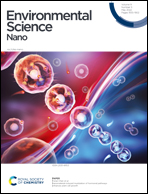Separation of lattice-incorporated Cr(vi) from calcium carbonate by converting microcrystals into nanocrystals via the carbonation pathway based on the density functional theory study of incorporation energy†
Abstract
Calcium carbonate easily allows foreign ions, such as Cr(VI), to incorporate into its lattice, leading to the long-term slow release of heavy metals and consequent environmental risk. Although CaCO3 is one of the major minerals in Cr-containing solid waste, little is known regarding the chemical speciation, potential for release and methods of separation of Cr(VI) from CaCO3. In this study, density functional theory (DFT) calculations were performed to figure out the Cr(VI) incorporation energy in different polymorphs of CaCO3. It was revealed that when co-occurring with calcite and vaterite, CrO42− is more easily incorporated into vaterite than in the calcite lattice due to lower doping resistance, while changing the Cr(VI) species from CrO42− to HCrO4− and Cr2O72− can significantly enhance the doping resistance. Based on these theoretical results, a CO2-assisted phase transformation method is proposed to separate lattice-incorporated Cr(VI) from CaCO3. Characterization results show that during carbonation (with 3 MPa CO2 and a liquid : solid ratio of 10 : 1) under acidic conditions generated by CO2 and H2O, CaCO3 microcrystals were converted to nanocrystals through a dissolution-reprecipitation process, and the incorporated Cr(VI) was released. Furthermore, increased doping resistance was observed, as Cr(VI) could not be re-doped onto nano-CaCO3 due to the ionic species changing from CrO42− to HCrO4− and Cr2O72−. As a result, 77.1% of incorporated Cr(VI) was separated from CaCO3 and the Cr(VI) toxicity of the residue decreased from 19.5 mg L−1 to 0.27 mg L−1. Furthermore, predictive experiments of the Cr(VI) leaching characteristics indicated that the stability of the residue was notably enhanced after carbonation treatment. This CO2-assisted phase transformation system provides a promising method for the separation of lattice-incorporated heavy metal pollutants, using a simple and low-cost method to mitigate the risk posed by the slow release of heavy metals from solid waste.



 Please wait while we load your content...
Please wait while we load your content...